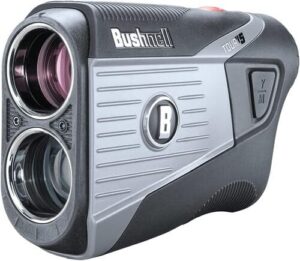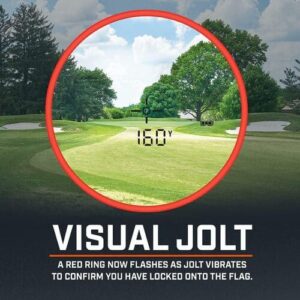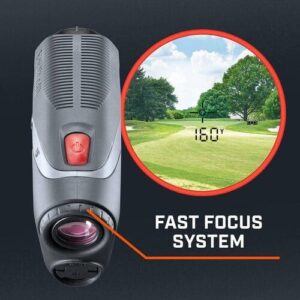Golf rangefinders, which are also called Distance Measuring Devices (DMD), have become more and more popular in recent years. This is because they offer valuable insights that can help golfers with their course management. But, like any other modern tool, they only work well when they are used the right way. So how do these laser rangefinders for golf work?
Laser Rangefinders: How Do They Work?
The Laser Rangefinder, commonly abbreviated as LRF, stands as a valuable instrument for acquiring precise distance measurements. Most laser rangefinders work based on a concept called “time of flight.”
In this method, a laser pulse is sent in the form of a narrow, focused beam towards the target object. The light is subsequently captured by a sensor, meticulously calculating the distance by measuring the time it takes for the light to return.
Even when measuring long distances, some high-end laser rangefinders can still be accurate to the millimeter level, which is pretty amazing.

Ultrasonic Rangefinders
Ultrasonic rangefinders use a technology very similar to the laser variations described above but with one difference, sound. Rather than using light, these devices use sound. However, the theory is the same. The principle of “time of flight” still applies here.
These devices emit a very high-frequency soundwave and measure the time it takes for the sound to bounce off the target and return. Distance is then calculated using the speed of sound.
Functions Of A Golf Rangefinder
Determining Distance To The Pin
A golf rangefinder’s main job is to give you an accurate measurement of how far away a particular target is from where you are. It does this by making the object bigger, like when you look through a scope, and sending a laser beam at it to figure out how far away it is.
In this situation, the goal can be different, but the flag or pin is usually the target. High-quality rangefinders use advanced technology to exactly find the thin flagpole against any background, so you can be sure that the yardage you get is correct.
Bushnell golf laser rangefinders, for example, use a system called “PinSeeker with JOLT.” This technology finds the flagpole and makes the device shake once it knows how far away the pin is. Other brands may need materials that reflect light on the pin in order to measure distance, but Leupold rangefinders beep when they find such materials.

If your rangefinder doesn’t have pin-seeking technology, you can still figure out how far away the pin is by aiming at a place right next to it and writing down the distance. Then, move the laser scanner over the pin. If the distance reading gets shorter, this is the exact distance to the pin.
Measuring Distance (From The Tee To Hazards)
Rangefinders are also great for figuring out how far you need to hit to clear hazards, whether you’re on the tee on a long hole and need to figure out how far water hazards, bunkers, or trees are, or you’re close to the green and need to clear bunker lips or figure out how steep the green is from a distance.
Accounting For Slope
Some golf laser rangefinders have a slope measurement that takes into account the change in height between where you are and where the target is. This makes the rangefinder more accurate, but it’s important to know that slope readings are usually not allowed in golf tournaments. Because of this, many companies make rangefinders like the Bushnell Tour V4 Slope that can switch between slope readings and standard measures.
Rangefinders In Golf Tournaments
Tour pros have usually used golf laser rangefinders or DMDs during practice rounds before tournaments to fine-tune their course management and make sure they are accurate throughout the event. Recently, some golf tours have started letting DMDs or rangefinders to be used during real event rounds. This is to see how they affect the flow of the game.
In addition to giving accurate distance readings, golf rangefinders help speed up the game. They get rid of the need to look for yardage marks on the golf course or use pin sheets to figure out distances. This is especially helpful for tee shots that could have numerous hazards to navigate.
Some players like rangefinders, but there are other DMD technologies that can help find targets without having to look through a scope.

Rangefinder Alternatives
Global Positioning System (GPS) technology presents itself as an alternative instrument that is gaining increasing popularity. On a course plan that comes with the GPS, it shows how far away the front, middle, and back of the greens are.
These devices include smartwatches and apps for smartphones, as well as small GPS computers like TomTom SatNavs that can be carried around in your pocket. GPS smartwatches are probably the fastest growing golfing accessory in recent years with companies like Garmin leading the way.
There is also much older technology that can also be an alternative, such as optical rangefinders. These have been around since the 1880’s and have no electronic parts.
There is no doubt that digital technology has changed the game of golf. For example, rangefinders seem to be taking on a more traditional role. Even so, they are still very important for speeding up rounds and making the game more accurate.
FAQs
Do all golf rangefinders have slope measurement capabilities?
No, not every golf rangefinder has the ability to measure slope. Some models are slope-enabled, while others can be used in tournaments as they don’t have slope features.
How do golf rangefinders help improve course management?
Golf rangefinders aid course management by providing precise distances to hazards, greens, and targets, helping golfers make informed club selections and shot strategies.
What are some well-known brands that manufacture high-quality golf rangefinders?
Well-known brands for high-quality golf rangefinders include Bushnell, Nikon, and Garmin.
Can rangefinders be used by golfers of all skill levels?
Yes, rangefinders are suitable for golfers of all skill levels, from beginners to professionals.
Are Golf Rangefinders expensive?
Yes, and no. There are some very high-quality, extremely accurate, and feature-packed rangefinders with significant price tags. However, there are also a wide variety of entry-level rangefinders that would be suitable for most golfers.
Where can I purchase a reliable golf rangefinder, and what factors should I consider when buying one?
Reliable golf rangefinders are available at golf specialty stores, online retailers like Amazon, and electronics outlets. Consider factors like accuracy, ease of use, and budget when making a purchase decision.
Final Thoughts
In the end, golf laser rangefinders, also called Distance Measuring Devices (DMD), have become more common because they help golfers better manage the course.
These devices use laser pulses and the “time of flight” concept to measure distances very accurately, down to the millimeter level. Golf rangefinders are very important for figuring out how far away pins, hazards, and other targets are. This helps players choose the right clubs and plan their game.
These rangefinders can be used by players of all skill levels and can help speed up the game without sacrificing accuracy. Also, new technologies are coming out, like GPS systems, trackers, and apps, but rangefinders are still an important part of modern golf.




